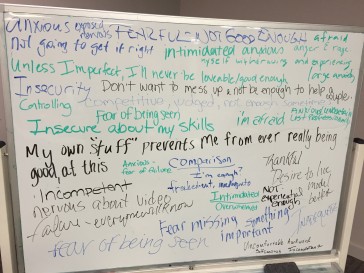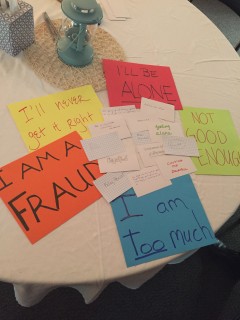
by Kathryn de Bruin | Jul 2, 2019 | Anxiety, Family Therapy
As parents, we have a big responsibility to help our children when they’re struggling with child anxiety.
So how do you then as a parent know what you should be doing versus what is hindering your children? Maybe it will help to first take a look at some statistics showing the prevalence of child anxiety.
DID YOU KNOW?
*16 million Americans suffer from Anxiety
*Children with anxiety who attend family therapy have an 80% success rate, as opposed to
children who do individual therapy without the family involvement – only 60%
*1 in 5 children have clinical levels of anxiety
*1/3 of children with ADHD have an anxiety disorder
*Anxiety is the leading mental disorder found in children
*Anxiety tends to run in families. Families interactions increase anxiety
Those are some DIFFICULT statistics to stomach. So what can we takeaway from all these?
Anxiety is a common childhood disorder and it can be managed
This is actually good news, because it lets you know just how common anxiety is, and also how researched it is. There is so much that can be done to manage anxiety. There are LOTS of tools and techniques available to us and especially for children, and ways we can be proactive parents in helping our children combat anxiety.
What kind of parenting PERPETUATES anxiety:
1. Parenting that offers less space and freedom to children
2. Parenting that gives children a lack of autonomy
3. Intrusive parenting where parents do for children what they could do for themselves
4. Parents who anxiously appraise situations and often find themselves saying: “No, don’t
do that, Don’t do that”. Children often adopt the way that parents see the world
5. Parents who often question children’s choices
vs
Parenting that creates RESILIENCY in children:
1. Rewarding your children for being proactive rather than reactive
2. Praising children for independent behavior
3. Allowing children to struggle rather than jumping in to help or doing things for them
Sometimes it’s hard to naturally do these things as parents. It’s hard to watch your children struggle, and obviously there is a line where you need to step in. But see if you can notice ways in your language and behavior where you can help your children have space. Space to learn and grow confident in their decisions, knowing they’ll always have your support.

by Kathryn de Bruin | Jul 1, 2019 | Anxiety, Family Therapy, Therapy
Breathing is one of the most natural and healthful functions of the body.
The inhalation of oxygen creates the beginning of an exchange as the gas moves into the millions of alveoli in the lungs, then on to the blood in the surrounding capillaries where it moves carbon dioxide from the blood to the alveoli. Breathing is, in most case, automatic.
The brain and small sensory organs signal when oxygen levels are too low or carbon dioxide levels are too high. In response to this signal, the brain increases the speed and depth of breathing. Deep breathing exercises have been used for years as a way of relaxing the body. Anyone who has ever noticed how an infant’s abdomen rises and falls with each breath has experienced the art of proper deep breathing.
Most adults today tend to fill only the upper chest when they breathe and thus miss how the increased oxygen intake relieves tension and improves metal alertness. By employing some of the more popular deep breathing exercises listed below you can strengthen the lungs, relieve bronchitis, improve circulation, oxygenate the blood and minimize the reoccurrence of respiratory ailments.
One of the fastest and most effective stress-relievers is the “4-7-8 breath”
1. Place the tip of your tongue against the bony ridge by your upper front
teeth
2. Breathe in through your nose for 4 counts
3. Hold your breath for 7 counts
4. Exhale through your mouth (making a whooshing sound) for 8 counts
Repeat this cycle 4 times, twice a day

by Kathryn de Bruin | Feb 24, 2019 | Anxiety, Family Therapy
Struggles with Child Anxiety: Is there really a way through this?
After our first blog entry of the series, I wanted to dive deeper into our family’s journey with anxiety and how we best combat it together. I have a sweet, soft hearted daughter, who can take life too seriously at times. She can err on the side of making others happy at her own expense and gets anxious about things that face her. This child anxiety has shown up at different parts of her development, be it separation anxiety in going to school, fear about monsters at nighttime in her bedroom, or fear about nightmares disrupting her sleep.
1. I Soothed Myself as a Parent
Seeing her develop these fears was so scary for me, because I’ve struggled with anxiety during my life. The last thing that I’ve ever want is for her to struggle the way that I have. And so I teetered on panicking when she started symptomizing and going to the worst case scenario – my daughter has an anxiety disorder and will struggle throughout her lifetime with this. After getting support for myself, I was able to make the switch to believe that I would be able to soothe her and could say to myself, my daughter is anxious at the moment (which is developmentally on par), but I can parent her through this and teach her how to manage these symptoms from early on, and she will be stronger and wiser growing up with learning how to
manage these challenges.
2. I Let Her Emote
She’s such an emotional little girl, and when she would emote and seem so sensitive I would start to worry, going into futuristic thinking. Anxiety always takes us into the past or the future, where we can’t fix anything. It’s important to recognize this and to stay in the present. I took a deep breath and picked her up in these moments. I let her sit on my lap and just held her tight. I’d say something my mom would say to me, “hold me tight and squeeze all the sadness into me”. Eventually her breathing would calm, and I could wipe her eyes. After leaning in, in this way time and time again, I can confidently say that it’s rare that she emotes in this seemingly intense way anymore. She’s learned to regulate herself a lot better. That’s a skill that children learn through experience, through being soothed regularly.
3. We Developed Rituals
We are a Christian family, and so we started making her bedtime predictable, and we set some rituals in place that she could count on. We pray together each evening, I’d make sure that her closet door is closed, and I tickle her back while we sing a song together. Our song is based on Psalm 4:8 and focuses on a God who is soothing and protective. She’s come to rely on doing this every night and I believe that the structure gives her peace and that the touch soothes her nervous system. The skin is the largest organ we have, and skin to skin contact can be an effective way of soothing.
4. We Built Her Confidence
Helping children to be assertive, and especially to have a ‘come back’, is very important in American culture. When her brother teases her, and always had the upper hand because he’s older and therefor more resourceful with his cognitive brain, I have taught her to stand up for herself. For a long time, after a smart comment from him, she’d run to me crying, looking for me to step in and take care of the situation. Instead of always stepping in, I started walking her through ways to deal with him. I’d ask her, “well do you believe what he said? Is it true? If it isn’t, what is true? What should we say back to him”, and we’d brainstorm a number of comebacks. Things like, “Why are you making a big deal about this? You can’t seem to leave me alone? You’re the one who’s being silly”….and so on and so on. Two years later, these come naturally for her and she can hold her own in social situations. She’s still a sensitive, sweet child, but she’s confident and can assert herself when others are giving her a hard time.
5. Finding Her Intuition
We take time for meditation, to slow down and to listen to the spirit/soul/body. When she’s uncertain about what to do, before giving her answers, I’ll ask her what her gut says, and get her to slow down to listen inside. I believe that this vital for a child to learn, that they have an intuition and that it can guide them in life. This is still rather abstract a concept for her, but we keep practicing this.

by Kathryn de Bruin | Feb 8, 2019 | Anxiety, Family Therapy
Having a child who develops symptoms of anxiety is awful. We worry about our children, but even worse, we feel so helpless as parents when we don’t know how to soothe them.
Soothing children is a primary function of being a parent, and so we end up feeling powerless when we can’t do so. We try our best to talk them out of the anxiety, to show them logically that what they are afraid of makes no sense. But the more we seem to talk them out of the anxiety, the more anxious they seem to get. And where does this leave us? If we can’t explain to them that their anxiety is irrational, then how do we help them? There is nothing rational about anxiety, it’s not a problem that we can fix by being rational. The good news is, that there is a lot that can be done. The body cannot be anxious and relaxed at the same time, and so learning how to soothe and bring the nervous system into a state of calm, will diminish the anxiety. There are countless ways of doing this and you can learn how to master these.
Anxiety is the most common emotional childhood disorder, and so learning to help children overcome this is important and will equip them with life-long skills. In fact, most adults can relate to having felt anxious at some point, and so you have the best resource within yourself, relating to how they feel in these moments of terror, and letting them know that they are not alone. Anxious moments are also common to growing up, almost like growing pains are to growth. They come during the various life stages and can be momentary as we adjust to the new challenges that life presents. Putting these symptoms into perspective, distinguishing when they are diagnosable vs a developmental growth phase is important. But either way, there is a lot to be learnt in how to reduce anxiety, which will equip you with valuable tools in managing life. Learning these tools goes hand in hand with slowing down when these symptoms arise, to evaluate your life style, to reduce stress, to listen to your child in a new way and to figure out what they need in order to be the very best version of them.
Start with learning as much about the anxiety as possible. Slowing down and tracking the symptoms, will be helpful in determining the cause of the anxiety, which will be helpful in treating it. The slowing down can be especially difficult, because anxiety breeds anxiety. We start to feel anxious ourselves that our children are anxious. And if we get caught up in a stressed-out brain and system, then we can’t see things and think clearly enough to figure out where the solutions may lie. As the airplane philosophy always reminds parents, put the oxygen mask on yourself before you place it on your child. The same philosophy applies here. You are often your child’s regulator, and so breathing deeply and calming yourself down first, will go a far way in you being able to soothe to your child.
So let’s rally together, there’s a lot I’d like to share. Journey with me through this blog series, and let’s get the best of the anxiety that plagues your family.
�

by Raindrop Administrator | Jan 8, 2016 | Anxiety, Emotions
Accepting Your Anxiety
Accepting that you get anxious can feel like you are surrendering to something awful. I encourage you to congratulate yourself because it’s not easy to recognize anxiety! In fact our anxiety often manifests itself in many different ways. For example many people believe that they are having a heart attack and end up in the local ER. Others focus on the external things, “If I just had a clean house I wouldn’t feel this way” or “If I just had a new job I’d be better.” Yet despite making many changes, we end up with the same symptoms reappearing over time. Finally we figure out that it’s our body that is undergoing a stress response.
So, seeing your anxiety and accepting that it’s something happening inside of you, that causes you to go into a fight and flight response, is a big first step!

Understanding Your Anxiety
Great! Now what? And it’s not all bad news. Identifying the problem is half the solution! Because you can manage what you know and can make sense of. The other good news is that you are not alone. 16 million Americans suffer from anxiety. This is actually good news, because it lets you know just how common anxiety is, and also how researched it is. There is a lot that can be done.

So now that you know it’s there, let’s start figuring out what’s going on. And to do that, you need to observe, be willing to learn, and to track well. Start a journal and write down everything that you notice about your stress response.
How do you know it’s anxiety? What in your body and mind tell you that? Is it something you keep thinking about? Or is it the pain you feel in your chest? Write down every symptom that you can. For a list of common symptoms, stay tuned; I will be covering this later this month.
Now start tracking these symptoms. Notice when they arise, and the intensity of the symptom. After collecting evidence for a couple days, what patterns have you noticed? Is your anxiety worse in the morning or afternoon? Does it present on a Monday morning after the weekend on your way back to work? Is it worse after you’ve eaten a certain food, or after you’ve been thinking about your deceased loved one? There is always a pattern, and there is always a reason. Start looking for this!
Managing Your Anxiety
Once you recognize you are anxious, your job is practice coping skills that will stop your fight-flight response and initiate a calming response. There are many different ways to do this. These include physiological ways, through deep breathing. Another way is to do exercise or progressive muscle relaxation, systematically tightening and relaxing your muscles. Make sure you are hydrated and stay away from caffeine, which aggravates anxiety. On a thought level, you are going to start to notice anxious thinking, and actively change the way you think. This will change the way you feel. Finally you are going to understand why your system has sent you anxiety, and understand what it is that your body is needing. Once you understand the root cause, and can take care of yourself in a different way, the anxiety won’t be necessary anymore.









